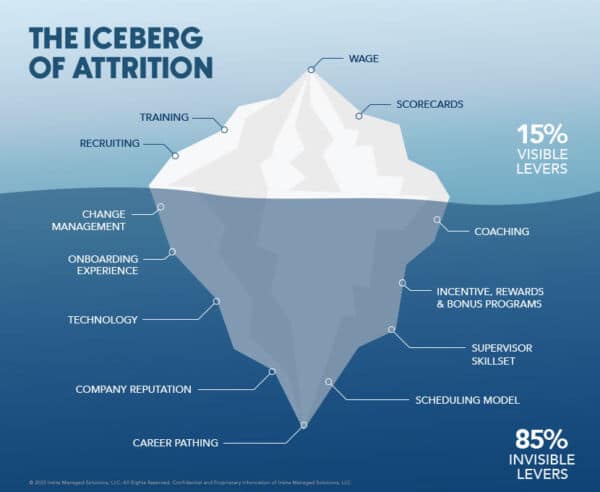

The Iceberg of Employee Attrition: The 85% You’re Not Seeing
Employee attrition is a significant problem for businesses of all sizes, yet retention’s most influential factors often go overlooked. It’s like an iceberg: the levers you can see only make up the tip. The visible issues, such as low wages and lack of benefits, only represent a tiny fraction of the problem – a mere 15%. The other 85% of levers contributing to employee attrition remain unseen and unresolved. Let’s explore the hidden depths of employee attrition and identify the critical 85% you’re not seeing.

The Tip of the Iceberg: Visible Attrition Levers
The global marketplace is a fast-moving and highly competitive ecosystem. So, it makes sense that many organizations only have the bandwidth to identify and review the most apparent attrition levers. You can find an endless stream of articles to guide you through the reconfiguration of your recruiting technology, your wage structure, training curriculums, and performance and quality scorecards. But even in the best-case scenario, mastering these four levers will only improve your attrition rate by 15%. That’s why time and time again, organizations quickly find themselves right back where they started, scratching their heads and wondering, “Why didn’t this work?!” When you’re blind to 85% of the problem, you incorrectly allocate your efforts and resources to fixing issues that only scratch the surface of your retention problem.
The 85% of Employee Attrition You’re Not Seeing
Companies often only aim to solve the visible levers by executing new training programs, updating recruitment processes, or restructuring pay scales. But in remaining blind to or forgetting about the hidden levers, these efforts prove to be fruitless, and retention rates continue to worsen. We can identify the true triggers of rising attrition by addressing the levers beneath the surface.
The Impact of These 9 Hidden Challenges can Wreak Havoc on Your Retention Rates
Change Management
Poor change management, especially when communicating large-scale operational changes, contributes to agent frustration. When agents are not well informed of impending changes and are not provided the resources to properly implement change, the resulting stress leads to diminished employee engagement and satisfaction, negatively impacting your customer-centric metrics.
Onboarding Experience
You only get one first impression, and that first impression is your onboarding program. Suboptimal onboarding plans are a leading contributor to high attrition. Employees require a comprehensive and inviting onboarding experience to hit the ground running with confidence that they can be successful in their role. Without processes to ensure new hires are knowledgeable and equipped with all necessary resources, you guarantee a poor employee experience and a lack of loyalty. Once this experience occurs, it’s hard to recover your employees’ commitment to their roles and your company. Too often, your employees leave to find an employer with greater focus where it matters.
Technology
Outdated and unintuitive technology drives the inability to manage call spikes effectively, navigate knowledge management platforms, track performance, and forecast efficiently, assigning unnecessary and heavy burdens to employees. Without proper tools, your employees are unsupported and cannot manage high call volumes, customer escalations, etc. This is a recipe for poor employee satisfaction, engagement, and burnout and motivates employee departure.
Company Reputation
Reputation is everything, and not just in terms of market value. Employees don’t just want to be proud of their work; they want to be proud of the company they work with. You can’t incite employee loyalty without a foundation and visible practice of intellectual capital, goodwill, and brand equity. If employees are promised they are joining a team of professionals that promote such assets and come to find the promise is a farce, you can say goodbye to your agent and hello to the job boards.
Career Pathing
Retaining your employees, particularly high-performing agents, requires an employee development-centric focus. 49% of agents reported that a clear path to career growth is a crucial influencer of their decision to remain employed with their current organization.
Coaching
58% of agents claim they “get very little from [their] company coaching sessions.” An efficient coaching program is critical to optimizing productivity and performance. Many companies focus solely on the training and performance feedback components, forgetting that a trusting coach and employee relationship and a recurring coaching feedback loop are critical to promoting improvement. Without consistent two-way feedback, there is no opportunity for the employee to communicate their experience or to collaborate with their coach on a plan for maximum success.
Incentives, Rewards & Bonus Programs
Always remember the power of motivation through performance incentives and rewards and metrics or value-based bonuses. Yes, this can be a significant line item in your operating budget; however, the cost of attrition far exceeds that of incentives. The alternative is to continue spending what the Harvard Business Review has determined to be 100-300% of an employee’s salary to replace every agent who leaves.
Supervisor Skillset
Our experts performed a cross-industry study to identify what it takes to create a high-performing supervisor. We identified the 10 skills to look for and train for to develop quality leaders:
- Customer engagement
- Metric & relationship management
- Operational economics
- Employee engagement
- Operational analytics
- Coaching
- Operational efficiencies
- Timeline metrics
- Performance improvement methods
- Business process management
It’s not easy to find a supervisor that demonstrates strength across all 10 skills, and without such skillful leadership, agents are poorly prepared to tackle their duties with efficiency and success. This leads to employee and employer-driven attrition, as job dissatisfaction and performance grow without comprehensive improvement plans.
Scheduling Models
Not only is employee desire for flexible scheduling this perk higher than ever, but so are their options for alternative employment if your organization can provide this benefit. Without implementing a flexible scheduling model, the 47% of agents that reported flexible scheduling as a key influencer to maintaining employment can easily find a position with the 78% of companies that do offer this benefit.
According to the 2022 NICE Workforce Management Global Survey, the most important components of flexible scheduling are:
- Flex breaks and lunchtimes – 78.3%
- Split-shift options – 77.9%
- Pre-approved extra hours – 75%
- Trade and swap shifts with coworkers – 74.2%
- Access to schedule changes 24/7 – 73.5%
- Pre-approved self-swap – 71%
The Solution: A Comprehensive Approach
Solutioning these 9 hidden challenges enables cultivating a working environment designed to boost retention and operational success. Are you ready to begin melting away the attrition iceberg? We’ve got you covered.
Start by eliminating four of these attrition drivers with our free resources:
- Change Management Toolkit – Discover how to execute seamless change communication and implementation to keep your employees engaged and confident in their work.
- Leading Teams to High Performance – Use our research to determine the maturity of your supervisor training program and leaders’ skillsets to cultivate leadership that incites employee engagement.
- Flexible Scheduling Due Diligence and Compatibility Checklist – Assess your current operational structure for compatibility with implementing a scheduling model that generates employee satisfaction.
- Coaching Tool – Use our coaching session guide to facilitate fruitful coaching sessions for employee growth and operational buy-in.
